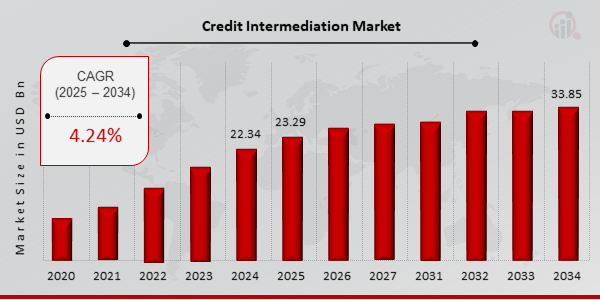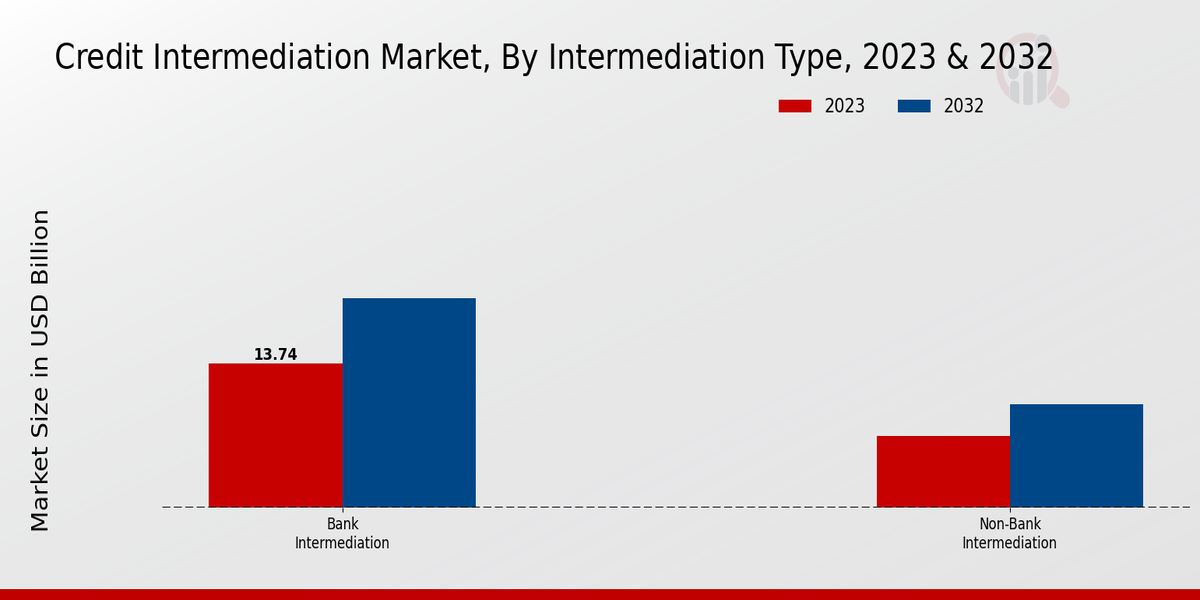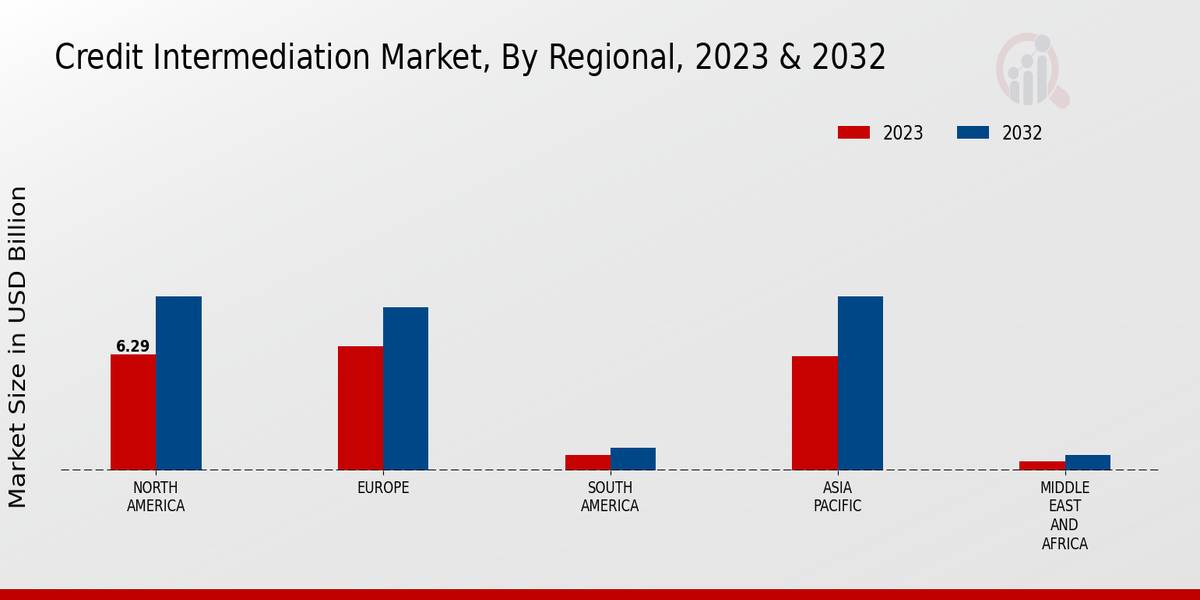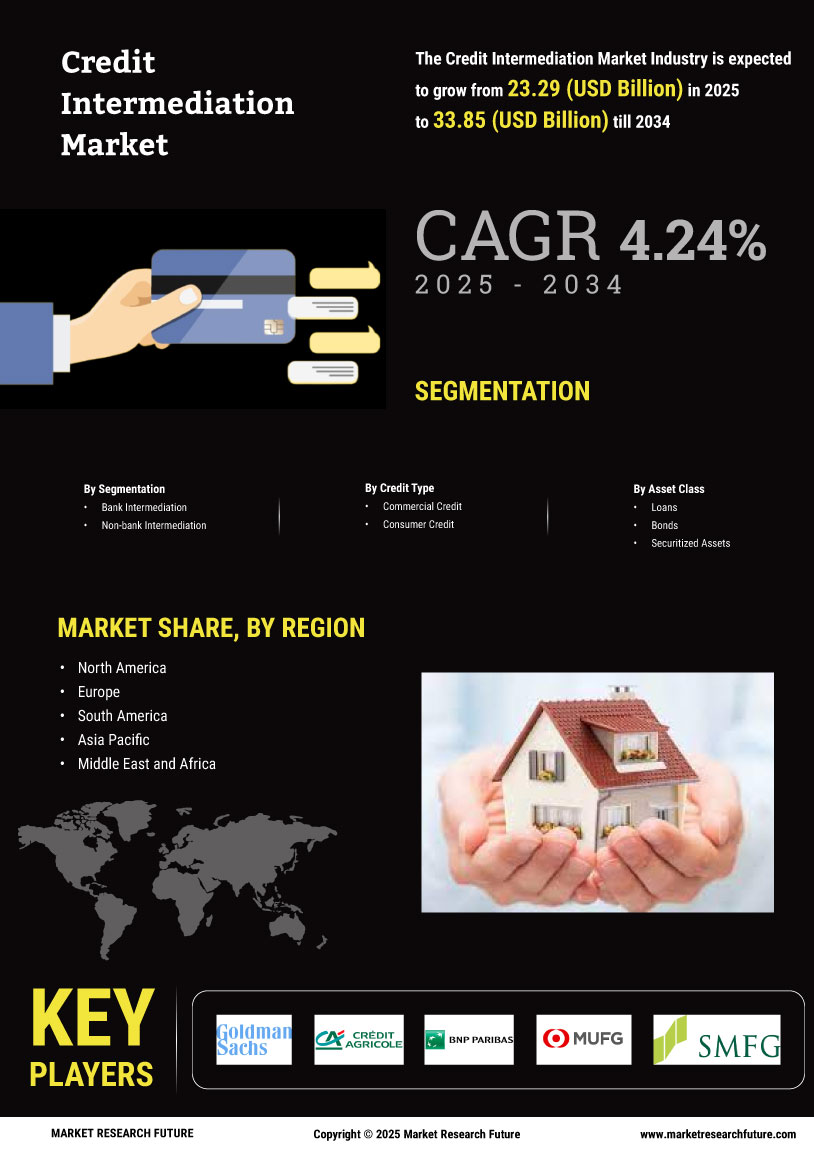Global Credit Intermediation Market Overview:
Credit Intermediation Market Size was estimated at 22.34 (USD Billion) in 2024. The Credit Intermediation Market Industry is expected to grow from 23.29 (USD Billion) in 2025 to 33.85 (USD Billion) till 2034, exhibiting a compound annual growth rate (CAGR) of 4.24% during the forecast period (2025 - 2034).
Key Credit Intermediation Market Trends Highlighted
The Credit Intermediation Market is witnessing a transformative shift toward digitalization and automation, driven by the proliferation of fintech solutions. The advent of online lending platforms and mobile banking applications has facilitated seamless access to credit for businesses and consumers alike, reducing traditional barriers to entry. This trend is expected to continue in the coming years, with financial institutions embracing innovative technologies to enhance customer experience and streamline operations. Furthermore, the growing focus on financial inclusion is creating opportunities for credit intermediaries to expand their reach to underserved populations. The increased demand for credit in emerging markets and the rising adoption of alternative lending models are fostering a favorable environment for growth. Additionally, the regulatory landscape is evolving to support responsible lending practices, ensuring the stability of the credit intermediation market. Recent trends in the credit intermediation market include the rise of peer-to-peer lending, the growing popularity of buy now, pay later (BNPL) financing, and the increasing use of artificial intelligence (AI) in credit assessment. These innovations are reshaping the industry, providing consumers with greater choice, flexibility, and convenience.

Source: Primary Research, Secondary Research, MRFR Database and Analyst Review
Credit Intermediation Market Drivers
Rising Demand for Credit
The Credit Intermediation Market Industry is majorly influenced by rising demand for credit from various sectors. Individuals, the government, and businesses have a continued demand for credit as a result of numerous growth drivers. Some of the factors include expected economic growth, increased rates of urbanization, and increased consumer spending. It is necessary for individuals to continue borrowing money to expand their businesses, develop infrastructure, and continue serving their consumption needs. Furthermore, the availability of credit products such as personal loans, mortgages and corporate bonds in high amounts ensures that the demand for credit intermediation stays high across different states.
Technological Advancements
The Credit Intermediation Market Industry is significantly influenced by technological advancements. The adoption of digital technologies, such as mobile banking, online lending platforms, and artificial intelligence (AI), is transforming the way credit intermediation services are delivered. These technologies enhance efficiency, reduce costs, and improve customer experience. Additionally, the use of big data and analytics enables lenders to make more informed credit decisions, leading to increased access to credit for borrowers.
Regulatory Changes
Regulatory changes play a crucial role in shaping the Credit Intermediation Market Industry. Governments worldwide are implementing regulations to ensure the stability and fairness of the financial system. These regulations aim to protect consumers from predatory lending practices, promote transparency in credit markets, and maintain financial stability. The evolving regulatory landscape influences the operations of credit intermediaries and requires them to adapt to changing requirements, which in turn affects the market dynamics.
Credit Intermediation Market Segment Insights:
Credit Intermediation Market Intermediation Type Insights
Intermediation Type Segment The Credit Intermediation Market can be segmented based on Intermediation Type into Bank Intermediation and Non-bank Intermediation. Bank Intermediation Bank Intermediation refers to the financial intermediation activities conducted by banks and other depository institutions. These institutions receive deposits from both individuals and organizations and use these funds to extend loans and offer credit to borrowers. They play an important role in the financial system of an economy by intermediating the process of savings and credit. The Bank Intermediation segment was the most prominent division of the Credit Intermediation Market in 2023 and is likely to continue this trend over the forecast period due to the extensive branch network, large customer base, and the regulatory framework of banks.
Non-bank Intermediation The Non-bank Intermediation section incorporates the financial intermediation activities of non-depository institutions. These intermediaries include credit unions, finance companies, and investment funds and provide a wide variety of credit products and services. These services range from personal and auto loans to home equity financing and fixed-rate mortgages. At times, non-depository institutions tend to serve specific customers or specialize in specific lending. Non-bank Intermediation is anticipated to exhibit the highest growth during the forecast period with the emergence of intermediation platforms such as marketplace lending and peer-to-peer lending. Key Insights The Credit Intermediation Market Intermediation Type segment offers key insights into the market dynamics and future of the industry based on this segment. Bank Intermediation remains the leading segment owing to the infrastructure and existing customer base of banks. The Non-bank Intermediation segment captures the highest growth rate with the intervention of intermediation by technological firms. As a result, this segment will likely intensify the competition in the Credit Intermediation Market.

Source: Primary Research, Secondary Research, MRFR Database and Analyst Review
Credit Intermediation Market Credit Type Insights
The Credit Intermediation Market is segmented by Credit Type into Commercial Credit and Consumer Credit. Commercial Credit accounted for a larger share of the market in 2023 and is expected to continue to grow at a faster rate through 2032. The growth of Commercial Credit is being driven by the increasing demand for business loans from small and medium-sized enterprises (SMEs). Consumer Credit, on the other hand, is expected to grow at a slower rate due to the increasing popularity of alternative lending options, such as peer-to-peer lending and online lenders.
Credit Intermediation Market Asset Class Insights
The Credit Intermediation Market is segmented by asset class into loans, bonds, and securitized assets. Among these, the loans segment held the largest share of the market in 2023, accounting for approximately 45% of the Credit Intermediation Market revenue. The growth of this segment can be attributed to the increasing demand for loans from various sectors such as corporate, retail, and real estate. The bonds segment is expected to witness significant growth over the forecast period, owing to the increasing issuance of bonds by governments and corporates to raise capital. The securitized assets segment is also expected to grow steadily, driven by the increasing demand for securitized products from investors seeking higher yields.
Credit Intermediation Market Regional Insights
The regional segmentation of the Credit Intermediation Market provides insights into market dynamics across key geographic regions. North America is expected to lead the market in terms of revenue, with a significant market share. The region's robust financial sector and well-developed credit infrastructure contribute to its dominance. Europe holds a strong position in the market, driven by the presence of major banks and a mature financial ecosystem. APAC is anticipated to exhibit substantial growth, owing to the rapid expansion of the banking sector and the increasing demand for credit in emerging economies like China and India. South America and MEA represent emerging markets with untapped potential for credit intermediation services. The growing middle class and the need for access to capital in these regions are expected to drive market growth in the coming years.

Source: Primary Research, Secondary Research, MRFR Database and Analyst Review
Credit Intermediation Market Key Players And Competitive Insights:
Major players in the Credit Intermediation Market industry are constantly striving to stay ahead of the competition and maintain their leadership position. Leading Credit Intermediation Market players are focusing on expanding their presence, developing innovative products and services, and leveraging technology to improve their offerings. The Credit Intermediation Market industry is characterized by intense competition, with several key players vying for market share. These players are investing heavily in research and development to stay ahead of the competition and differentiate their offerings. They are also forming strategic partnerships and collaborations to expand their reach and gain a competitive advantage. The Credit Intermediation Market Competitive Landscape is expected to remain competitive in the years to come, with new entrants and existing players vying for market share. One of the leading players in the Credit Intermediation Market is Citigroup. The company offers a wide range of financial products and services, including credit intermediation, wealth management, and investment banking. Citigroup has a presence, with operations in over 100 countries. The company is known for its strong brand recognition and its ability to provide innovative financial solutions to its clients. Another leading player in the Credit Intermediation Market is JPMorgan Chase. The company offers a comprehensive suite of financial services, including credit intermediation, asset management, and commercial banking. JPMorgan Chase has a presence, with operations in over 60 countries.
The company is known for its strong financial performance and its commitment to providing high-quality customer service. A major competitor in the Credit Intermediation Market is Bank of America. The company provides a wide range of financial products and services, including credit intermediation, wealth management, and investment banking. Bank of America has a presence, with operations in over 35 countries. The company is known for its strong customer service and its ability to provide innovative financial solutions to its clients. Another major competitor in the Credit Intermediation Market is Wells Fargo. The company offers a comprehensive suite of financial services, including credit intermediation, asset management, and commercial banking. Wells Fargo has a national presence, with operations in all 50 states. The company is known for its strong brand recognition and its commitment to providing high-quality customer service.
Key Companies in the Credit Intermediation Market Include:
- The Goldman Sachs Group, Inc.
- Crédit Agricole SA
- BNP Paribas SA
- Mitsubishi UFJ Financial Group, Inc.
- Sumitomo Mitsui Financial Group, Inc.
- Standard Chartered plc
- Citigroup Inc.
- Société Générale SA
- JPMorgan Chase Co.
- HSBC Holdings plc
- Mizuho Financial Group, Inc.
- DBS Group Holdings Ltd.
- Deutsche Bank AG
- Barclays plc
- Bank of America Corporation
Credit Intermediation Industry Developments
The Credit Intermediation Market is projected to reach USD 29.87 billion by 2032, exhibiting a CAGR of 4.24% from 2024 to 2032. The market growth is attributed to the increasing demand for financial intermediation services, rising disposable income, and the growing adoption of digital banking solutions. Recent developments in the market include the launch of new lending products, partnerships between banks and fintech companies, and the emergence of alternative lending platforms. Key players in the market are focusing on expanding their geographical presence, offering customized solutions, and leveraging technology to enhance customer experience.
Credit Intermediation Market Segmentation Insights
- Credit Intermediation Market Intermediation Type Outlook
- Bank Intermediation
- Non-bank Intermediation
Credit Intermediation Market Credit Type Outlook
- Commercial Credit
- Consumer Credit
Credit Intermediation Market Asset Class Outlook
- Loans
- Bonds
- Securitized Assets
Credit Intermediation Market Regional Outlook
- North America
- Europe
- South America
- Asia Pacific
- Middle East and Africa
Credit Intermediation Market Report Scope
|
Report Attribute/Metric
|
Details
|
|
Market Size 2024
|
USD 22.34 Billion
|
|
Market Size 2025
|
USD 23.29 Billion
|
|
Market Size 2034
|
USD 33.85 Billion
|
|
Compound Annual Growth Rate (CAGR)
|
4.24% (2025-2034)
|
|
Base Year
|
2024
|
|
Market Forecast Period
|
2025-2034
|
|
Historical Data
|
2020-2023
|
| Market Forecast Units |
USD Billion |
| Key Companies Profiled |
The Goldman Sachs Group, Inc., Crédit Agricole SA, BNP Paribas SA, Mitsubishi UFJ Financial Group, Inc., Sumitomo Mitsui Financial Group, Inc., Standard Chartered plc, Citigroup Inc., Société Générale SA, JPMorgan Chase Co., HSBC Holdings plc, Mizuho Financial Group, Inc., DBS Group Holdings Ltd., Deutsche Bank AG, Barclays plc, Bank of America Corporation |
| Segments Covered |
Intermediation Type, Credit Type, Asset Class, Regional |
| Key Market Opportunities |
Digitalization of credit processes Expansion into emerging markets Growing demand for alternative lending Focus on personalized financial products. Increased adoption of fintech services |
| Key Market Dynamics |
Rising demand for credit.Increased regulatory scrutiny.Technological advancements.Competition from nontraditional players.Changing consumer preferences. |
| Countries Covered |
North America, Europe, APAC, South America, MEA |
Frequently Asked Questions (FAQ) :
The Credit Intermediation Market is expected to reach USD 22.34 billion in 2024 and is projected to grow at a CAGR of 4.24%, reaching USD 33.85 billion by 2034.
North America and Europe are the dominant regions in the Credit Intermediation Market, accounting for a significant share of the Asia-Pacific is expected to witness the highest growth rate during the forecast period due to the increasing demand for credit intermediation services in emerging economies.
Credit Intermediation services are primarily used to facilitate various types of financial transactions, including lending, borrowing, and investment. These services are essential for businesses and individuals to access capital and manage their financial risks.
The Credit Intermediation Market is highly competitive, with a number of established players operating on a Some of the key competitors include banks, non-bank financial institutions, and fintech companies.
The growth of the Credit Intermediation Market is driven by several factors, including increasing demand for credit from businesses and individuals, rising disposable income, and favorable government regulations.
The Credit Intermediation Market faces challenges such as increasing competition, regulatory changes, and the emergence of new technologies that are disrupting traditional business models.
The Credit Intermediation Market is witnessing several key trends, including the adoption of digital technologies, the rise of fintech companies, and the increasing focus on customer experience.
The Credit Intermediation Market is projected to grow at a CAGR of 4.24% during the forecast period from 2024 to 2032.
The Credit Intermediation Market presents significant growth opportunities for players who can adapt to changing market dynamics and leverage new technologies to meet the evolving needs of customers.
Investing in the Credit Intermediation Market carries potential risks, including credit risk, interest rate risk, and regulatory risk. It is important for investors to carefully assess these risks before making investment decisions.

















